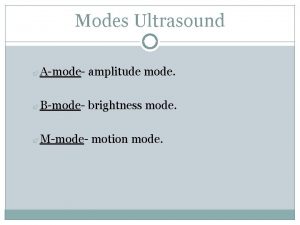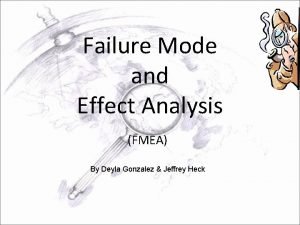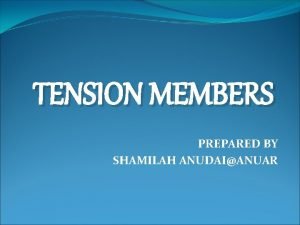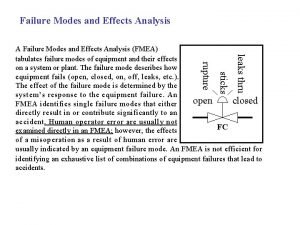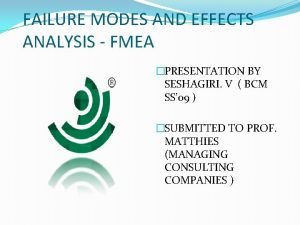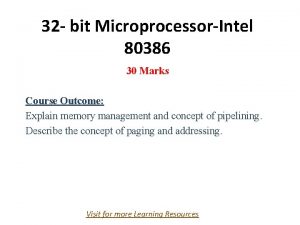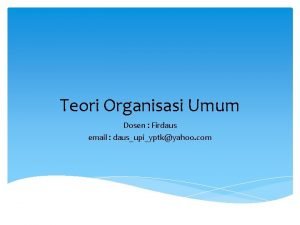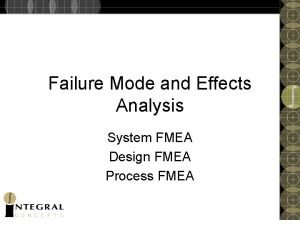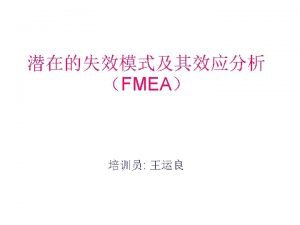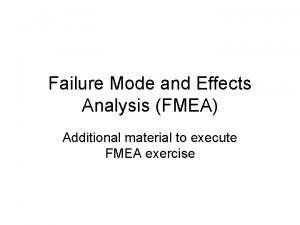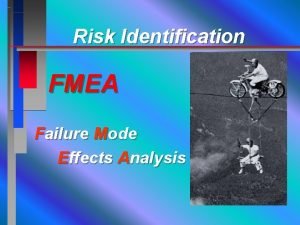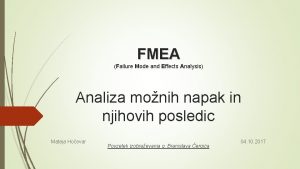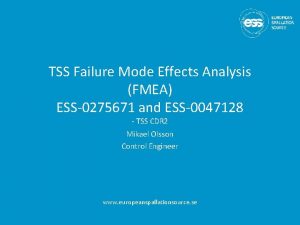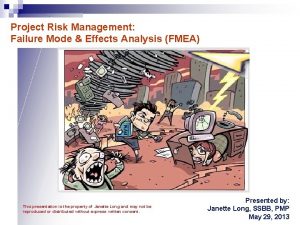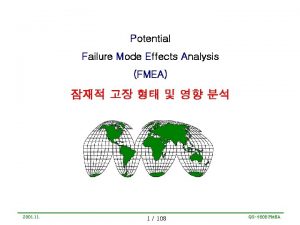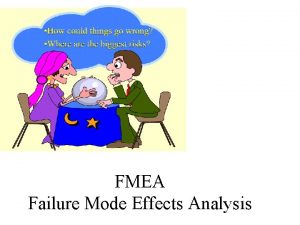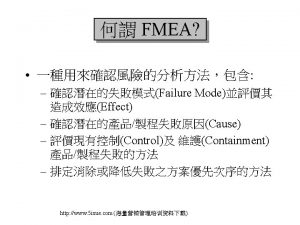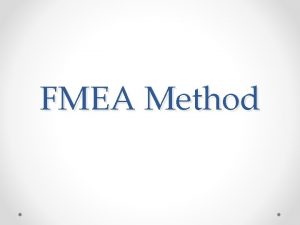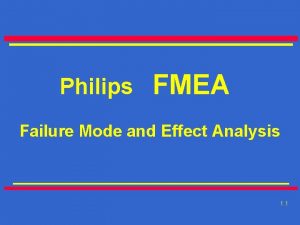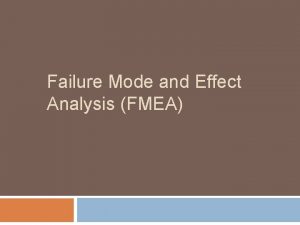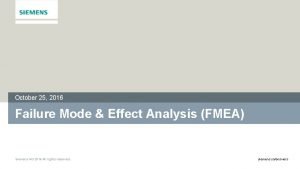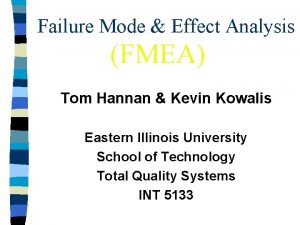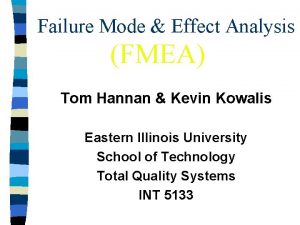Failure Mode and Effects Analysis FMEA Additional material




















- Slides: 20

Failure Mode and Effects Analysis (FMEA) Additional material to execute FMEA exercise

Definitions Failure Mode: is the way in which the failure is manifested. Failure effect: is the consequence of the failure. Failure cause: is what induces the failure. Escalante (2003)

Failure Mode and Effects Analysis Abbreviated Approach Item Function Potential Failure Mode Potential Effect(s) of Failure S e v C l a Potential Causes/ s Mechanisms(s) s Failure O c c u r D R e P t e N Recommended c Action(s) Prevention/Detection Current Controls Actions Results Responsibility & Target Completion Date Actions Taken S O D R e c e P v c t N What can be done? What are the Effect(s)? What are the functions, features or requirements? What can go wrong? - No Function - Partial/ Over/ Degraded Function - Intermittent Function - Unintended Function How bad is it? - Design changes How often does it happen ? What are the Cause(s)? How good is this method at How can this detecting be prevented it? and detected? - Process changes - Special controls - Changes to standards, procedures, or guides Who is going to do it and when? What did they do and what are the outcomes

FMEA (cont. ) Item/Function Potential S C Potential Cause(s)/ Failure Effect(s) e l Mechanism(s) of (9) Mode of failure v a failure s (10) (11) (14) (12) (13) (9) Name of the item and its intended function (purpose/objective). (10) Include specific problems, failures, defects (anti-functions) of the analyzed system(*) and its functions. Use physical terms. (11) The effect of failures in the function of the analyzed system, as they would be perceived by the customer (internal/external). (12) Evaluation of the severity of the effect of the failure to the next system or to the internal/external customer. Sometimes large values of severity can be reduced by means of design reviews that compensate or mitigate the resulting severity. (*) subsystem or componen

FMEA SEVERITY EVALUATION CRITERIA: Severity of Effect RANK Hazardouswithout warning Very high severity ranking when a potential failure mode affects safe vehicle operation and/or involves noncompliance with government regulation without warning 10 Hazardouswith warning Very high severity ranking when a potential failure mode affects safe vehicle operation and/or involves noncompliance with government regulation with warning 9 Very High Vehicle/item inoperable (loss of primary function). 8 High Vehicle/item operable but at a reduced level of performance. Customer very dissatisfied. 7 Moderate Vehicle/item operable but Comfort/Convenience item(s) inoperable. Customer dissatisfied. 6 Low Vehicle/item operable but Comfort/Convenience item(s) operable at a reduced level of performance. Customer somewhat dissatisfied. 5 Very Low Fit & Finish/Squeak & Rattle item does not conform. Defect noticed by most customers (greater than 75%). 4 Minor Fit & Finish/Squeak & Rattle item does not conform. Defect noticed by 50% of customers. 3 Very Minor Fit & Finish/Squeak & Rattle item does not conform. Defect noticed by discriminating customers (less than 25%). 2 None No discernible effect. 1 (D, F, GM. FMEA, 2001) EFFECT

Very high severity ranking when a potential failure mode affects safe operation and/or involves noncompliance with regulations without warning. Or may endanger operator without warning. Hazardouswith warning Very high severity ranking when a potential failure mode affects safe operation and/or involves noncompliance with regulations with warning. Or may endanger operator with warning. Very high Product/item inoperable, with loss of primary function. Or 100% of product may have to be scrapped or repair time >1 h. High Moderate Product/item operable, but at reduced level of performance. Customer dissatisfied. Or product may have to be sorted and less than 100% scrapped. Repair time between 0. 5 and 1 h. Product/item operable, but comfort/convenience inoperable. Customer dissatisfied. Or a portion (less than 100%) of the product may have to be scrapped with no sorting. Repair time less than 0. 5 h Ranking 10 9 8 7 6 In the third edition this table is presented in two columns but the information (customer effect and manufacturing/assembly effect). Hazardouswithout warning PROCESS ---------------------------Criteria: SEVERITY of Effect (D, F, GM. FMEA, 2001) Effect

Low Very Low Minor Very Minor None Product/item operable, but comfort/convenience operable at a reduced level. Or than 100% of the product may have to be reworked with no sorting. Repairing off-line. Fit and finish/squeak and rattle item does not conform. Defect noticed by most customers (greater than 75%). Or product may have to be sorted with no scrap, and a portion (less than 100% reworked. Fit and finish/squeak and rattle item does not conform. Defect noticed by 50% of the customers. Or a portion (less than 100%) of the product may have to be reworked with no scrap. On-line but outof-station. Fit and finish/squeak and rattle item does not conform. Defect noticed by discriminating customers (less than 25%). Or a portion (less than 100%) of the product may have to be reworked with no scrap. On-line but in-station. No discernible effect. Or slight inconvenience to operation or operator, or no effect. 5 4 3 2 1 (D, F, GM. FMEA, 2001)

FMEA (cont. ) Item/Function Potential S C Potential Cause(s)/ Failure Effect(s) e l Mechanism(s) of (9) Mode of failure v a failure s (10) (11) (14) (12) (13) Indicates any special characteristic (critical, key, major) that will require special controls. Some of the D, F, GM special symbols can be used. (An indication of criticality is when severity is 9 or 10, being the occurrence and detection geater than 3. (Stamatis, 1995)). (14) Describe what causes the failure modes. Discover the root causes.

Product/ function Potential failure mode Potential failure effects S e v Name of the item and its. Include specific The effect of failures in the intended function problems, failures, function of the analyzed (purpose/objective). defects (antisystem, as they would be functions) of the perceived by the customer analyzed system(*) (internal/external) and its functions. Use field data, previous physical terms FMEAs, warranties, etc. Begin with previous Examples: Noise, erratic operation, FMEAs, brainstorming. Use technical terms. unstable, inoperative. . . Examples: Cracked, loosened, fractured, leaking. . . Summary of FMEA C l a s Potential causes/ mechanism of failures Describe what causes the failure modes. Find the root cause. Typical causes: Incorrect material specified, Inadequate design life assumption, Over-stressing Insufficient lubrication capability Typical mechanisms: Wear, fatigue, corrosion

FMEA (cont) (15) (16) (17) (18) (19) (20) (15) Frecuency of the cause from 1 to 10. Statistically assigned if having information about similar components, systems or sub-systems. Otherwise use the following table. (16) List the verification/validation design activities or others related activities. The prevention controls are preferred. It’s recommended to use two columns to define the two types of controls: (P) for prevention, (D) for detection.

High: Frequent failures Moderate: Occasional failures Low: Relatively few failures Remote: Failure is unlikely Likely Failure Rates Over Design Life ³ 100 per thousand vehicles/items Ranking 50 per thousand vehicles/items 9 20 per thousand vehicles/items 8 10 per thousand vehicles/items 7 5 per thousand vehicles/items 6 2 per thousand vehicles/items 5 1 per thousand vehicles/items 4 0. 5 per thousand vehicles/items 3 0. 1 per thousand vehicles/items 2 £ 0. 01 per thousand vehicles/items 1 10 (D, F, GM. FMEA, 2001) DESIGN OCCURRENCE EVALUATION Probability of Failure Very High: Persistent failures

FMEA (cont) (15) (16) (17) (18) (19) (20) There are 2 type of controls according to its importance: i) Prevention. To prevent the cause/mechanism or the effect/failure mode, or reduce its occurrence. ii) Detection. To detect the cause/mechanism or the effect/failure mode by either analytic of physical methods. Preventive controls are related to the reduction of OCCURRENCE and not to the evaluation of DETECTION

DFMEA (cont) (15) (16) (17) (18) (19) (20) (17) Is the evaluation associated to the best detection control listed in the design control (relative evaluation for every individual FMEA). A scale from 1 to 10 is used. The suggested evaluation criteria is shown in the following table. (18) (Risk Priority Number). Evaluation of the design’s risk. Varies between 1 and 1000: RPN= (S)x(O)x(D)

(D, F, GM. FMEA, 2001)


FMEA (cont) (15) (16) (17) (18) (19) (20) (19) Attention should be focused on high values of severity, and high RPN, and in general, independently of the RPN when the severity is 9 or 10. The goal is first to reduce severity, then reduce ocurrence, and last to reduce detection. It is desirable that the recommended actions reduce the risk and increase customer satisfaction by means of an improved design.

FMEA (cont) (15) (16) (17) (18) (19) (20) -Only the design reviews can reduce severity. -To reduce occurrence the causes or failure mechanisms must be eliminated or controlled through design reviews. -To improve detection, the design verification and validations actions should be increased. If there are no actions, write “none”. (20) Define the responsible person and the completion date.

O c u r r Current design controls (prevention/detection) D e t e c List the design verification and validation activities. Include current control like field tests, laboratory studies and prototype testing applied to this or to similar designs. There are 2 type of controls according to its importance: i) Prevention. To prevent the cause/mechanism or the effect/ failure mode, or reduce its occurrence. ii) Detection. To detect the cause/mechanism or the effect/ failure mode by either analytic of physical methods. R P N Recommended actions Responsibility & target completion date Determine and apply improvement Define the responsible actions. If they are not necessary person and the completion write the word “none” date To reduce occurrence the causes or failure mechanisms must be eliminated or controlled through design reviews. To improve detection, the design verification and validations actions should be increased. If there are no actions, write “none”. It’s preferable to reduce -in that order, severity, occurrence and detection Summary of FMEA (cont. )

FMEA (21) (22) (21) Register the implementation date and a brief description of the action taken. (22) After the implementation of the corrective actions, re-evaluate the severity, occurrence and detection. If necessary repeat steps 19 -22. Don´t forget the follow up actions.

ACTION RESULTS S e Actions taken v Register the implementation date and a brief description of the action taken. Re-evaluate RPN. O c u r D e t c R P N
 Amplitude mode
Amplitude mode Failure mode and effect analysis
Failure mode and effect analysis Failure to sense
Failure to sense Pacer failure to sense
Pacer failure to sense Ductile break
Ductile break What is tension member
What is tension member Fmea analysis
Fmea analysis Fmea presentation
Fmea presentation Focus mode and diffuse mode
Focus mode and diffuse mode Real protected and virtual modes of 80386
Real protected and virtual modes of 80386 8086 vs 8088
8086 vs 8088 Mode địa chỉ tức thì là mode
Mode địa chỉ tức thì là mode In auto-reload mode a timer t0 in 8051 operates as
In auto-reload mode a timer t0 in 8051 operates as Gartner mode 1 mode 2
Gartner mode 1 mode 2 Perbedaan (planning mode) dan (evolutionary mode)
Perbedaan (planning mode) dan (evolutionary mode) สัญลักษณ์gd&t
สัญลักษณ์gd&t Examples of non material culture
Examples of non material culture The knowledge language values customs and material objects
The knowledge language values customs and material objects Example of material culture
Example of material culture Harmful and useful materials
Harmful and useful materials System fmea definition
System fmea definition
